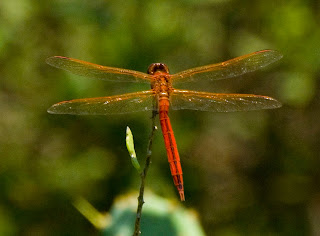August, a month of hot and dry. Rice is being cut, fields are starting to flower, and the woods and wires are starting to attract migrants. The resident birds have largely finished nesting, and large groups of local blackbirds and waterbirds are starting to build.
As the month started, I spent some time drifting around the prairie. There wasn't a lot of wet habitat, so what ponds were there held a lot of birds. The scene below is typical of what one might see in such a pond, although what you can't see is the cloud of birds that were behind the levees. I didn't see them until a farmer pulled up next to me and told me he was going to scare them so they didn't eat all of the feed he'd just put in for the crawfish, "But I'm just shooting in the air." He proceeded to drive the complex of levees, firing a pistol into the air, and everything got up. Of course, it all just moved over a pond, again and again, staying one step ahead of the noise. There was a good mix of species, including a lot of ibis, many shorebirds, and a bunch of ducks. The Black-bellied Whistling Ducks in the photos are part of a recent huge increase and expansion of the species.
Nowadays, when we talk of the SWLA prairie, we pretty much just mean the flat ground. If you want to find real prairie here, there's not much option. Most of the prairie ecosystem was plowed up in the late 1800s by homesteaders like my great-grandfather. Today, there are only a few patches left, mostly along railroad rights-of-way, and most are disappearing quickly. I find it pretty depressing to visit these sites, but one day a few weeks ago Dave Patton was going and I tagged along. Look at these stands of Blazing Star, imagine 2.5 million acres of land that looked like this, as well as the Rattlesnake Master, Greater Prairie Chickens, Louisiana Prairie Voles, and Lord knows what else disappeared to build Acadiana, and try not to be melancholy. I can't. If only we had set a little aside!
Over the past couple of weekends, I've made trips to the coast to watch the slow buildup of migration. Ragweed is starting to flower, the sun is sliding south, and we even had a few days of pleasant north wind. The table is spread, but only a few visitors have arrived yet.
Some of the earliest migrants are warblers and flycatchers. Prairie Warblers start showing up by early August.
Migrant Yellow-bellied Flycatchers arrive soon after, as do Great-crested Flycatchers and Eastern Kingbirds.
Some prickly pear cactus are flowering, but many are filled with slowly purpling fruit. These fruit are the tunas that shipwrecked and starving Cabeza de Vaca and his native hosts waited all summer to gorge and fatten on, not too far away on the Texas coast. I can only imagine what it must have been like to live out among the mosquitoes and heat all year around. A day afield at this time of year, even with AC waiting in my car, is enough for me.
Birds like the Downy Woodpecker and Common Nighthawk know what the coastal summer feels like, though. They can be found nesting right up to the Gulf beach where proper habitat can be found. The nighthawks will be pulling out soon, but the Downy will enjoy our cool winter that's only a couple of months away.
August is a great time for insects, too. Some, like mosquitoes and deerflies, make life hard for birders. Others, like dragonflies, make life hard on mosquitoes and deerflies--and are easy on the eyes, too.
On the beach, there are signs of the season changing, as well. Laughing Gulls are losing their black caps.
Wilson's Plovers are ready to head south, while Piping Plovers find August a good month to head to Louisiana.
Some birds that have over-summered, like this group of three Lesser Black-backed Gulls that's been around on Holly Beach since at least May, may be regretting having vacationed here with their Laughing Gull cousins, but they're starting to slowly look a little less scraggly, and fall is almost here.
The skies are also starting to change. Broad-winged Hawks start arriving along the immediate coast in good numbers in August, and will build into huge flocks passing through on their way south in September and October. Swallows, such as the Cave Swallow below, are prone to wander at this time. Although some swallows are already on the wing to their winter homes, others are drifting away from their nest sites and wandering around the countryside, with many finding themselves along the coast.
Some birds are best seen at this time of year. While the pewee at the top is a regular migrant in both spring and fall, the Olive-sided Flycatcher below is much easier to find in fall.
While the two species look a bit alike, differences in their habits are usually a good clue to their identity. Take a look at the following pictures of Olive-sided Flycatchers and see if you can guess where to look for them.
Luckily, dead snags are in good number in Cameron Parish at the moment following two big hurricanes in the past decade, so Olive-sideds can almost take their pick. They are the flycatcher most likely to use this type of perch here, although the scene below shows that sometimes Eastern Kingbirds (bird on right) keep them company there.
For birders that don't mind this kind of weather there's some good stuff to see right now, but some of it we'll have to see soon.
Take care, enjoy the last few days of August, and be sure to celebrate the common birds!






























No comments:
Post a Comment